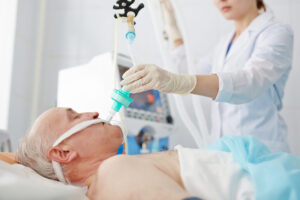Learning objectives
- Describe the implications and risk factors of awareness during anesthesia
- Prevent awareness during anesthesia
- Diagnose and manage patients who experienced awareness during anesthesia
Definition & mechanisms
- Rare but severe complication of anesthetic care
- Also referred to as “accidental awareness during general anesthesia” (AAGA)
- Mostly occurs during induction and emergence
- Can range from only auditory or tactile awareness to being fully awake with paralysis and pain
- Traumatic experience with possibly severe long-term effects (post-traumatic stress disorder)
Risk factors
- Neuromuscular blocking
- Female gender
- Pregnancy
- Cardiothoracic patients
- Obesity
- Total intravenous anesthesia
- Trauma & emergency surgery
- Ketamine, etomidate, and thiopental use
- Difficult intubation
- History of AAGA
- Chronic drug use
- Lack of monitoring
Psychological assessment and diagnosis
- Acute stress disorder (ASD): Occurs shortly after traumatic event (3 days to 1 month)
- Diagnosis: at least 9 of the following symptoms:
- Recurring, uncontrollable, and intrusive distressing memories of the event
- Recurring nightmares of the event
- Flashbacks of the event
- Intense psychological or physical distress when reminded of the event
- Persistent inability to experience positive emotions
- Altered sense of reality
- Memory loss for an important part of the traumatic event
- Efforts to avoid distressing memories, thoughts, or feelings associated with the event
- Efforts to avoid external reminders associated with the event
- Disturbed sleep
- Irritability or angry outbursts
- Hypervigilance
- Concentration difficulties
- Exaggerated startle response
- Diagnosis: at least 9 of the following symptoms:
- Post-traumatic stress disorder (PTSD): Diagnosed when symptoms persist for more than 1 month after the traumatic event
Prevention
- Check equipment and medications
- Depth of anesthesia monitoring (EEG is superior to BIS)
- Avoid or minimize the use of neuromuscular blocking agents
- Monitor neuromuscular block if neuromuscular blocking is necessary
- Use target-controlled infusion for total IV anesthesia
Management
Management is based on treating psychological symptoms:
- Early face-to-face postoperative meeting with the patient and consultation with a psychiatrist or psychologist
- Psychological interventions (e.g, cognitive behavioral therapy)
- Antidepressants
- Benzodiazepines for acute anxiety (beware of potential abuse)
- Antipsychotics may be helpful in some patients
Suggested reading
- Kim MC, Fricchione GL, Akeju O. Accidental awareness under general anaesthesia: Incidence, risk factors, and psychological management. BJA Education. 2021;21(4):154-61.
- Mashour GA, Avidan MS. Intraoperative awareness: controversies and non-controversies. Br J Anaesth. 2015;115 Suppl 1:i20-i26.
- Tasbihgou SR, Vogels MF, Absalom AR. Accidental awareness during general anaesthesia – a narrative review. Anaesthesia. 2018;73(1):112-22.
- Mashour GA, Orser BA, Avidan MS, Warner DS. Intraoperative Awareness: From Neurobiology to Clinical Practice. Anesthesiology. 2011;114(5):1218-33.
We would love to hear from you. If you should detect any errors, email us customerservice@nysora.com







